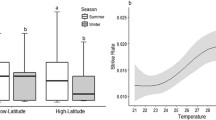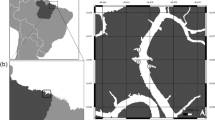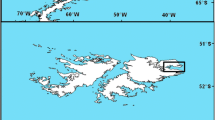Abstract
We observed a colony of marine iguanas (Amblyrhynchus cristatus) on Isla Fernandina, Galápagos, Ecuador, while measuring local micrometeorological and tidal conditions. We found size-related differences in foraging mode, with smaller iguanas feeding intertidally during daytime low tides and larger iguanas feeding subtidally. Despite having greater opportunity, subtidal foragers did not time their foraging bouts or exploit their environment in ways that optimized their period at high body temperature. Instead, the foraging schedule of these iguanas served to maximize their rate of rewarming following emergence from the cool sea. Intertidal feeders, by contrast, showed much greater behavioral flexibility in attempting to exploit their thermal environment. We suggest that size-ordered differences in marine iguana thermoregulatory behavior reflect underlying ontogenetic changes in costs and benefits of thermoregulation due to differences in predator pressure, quantity of food and electrolytes taken at each feeding, mode of foraging, and agonistic tendencies.
Similar content being viewed by others
References
Bakken GS (1976a) A heat transfer analysis of animals: unifying concepts and the application of metabolism chamber data to field ecology. J Theor Biol 60: 337–384
Bakken GS (1976b) An improved method for determining thermal conductance and equilibrium body temperature with cooling curve experiments. J Therm Biol 1: 169–175
Bakken GS, Gates DM (1975) Heat-transfer analysis of animals: Some implications for field ecology, physiology, and evolution. In: Gates DM, Schmerl RB (eds) Perspectives of biophysical ecology. Springer Verlag, New York, pp 255–290
Bakken GS, Vanderbilt VC, Buttemer WA, Dawson WR (1978) Avian eggs: Thermoregulatory value of very high near-infrared reflectance. Science 200: 321–323
Bartholomew GA (1966) A field study of temperature relations in the Galápagos marine iguana. Copeia 1966: 241–250
Bartholomew GA, Bennett AF, Dawson WR (1976) Swimming, diving, and lactate production of the marine iguana, Amblyrhynchus cristatus. Copeia 1976: 709–720
Bennett AF, Dawson WR, Bartholomew GA (1975) Effects of activity and temperature on aerobic and anaerobic metabolism in the Galápagos marine iguana. J Comp Physiol 100: 317–329
Boersma PD (1982) The benefits of sleeping aggregations in marine iguanas, Amblyrhynchus cristatus. In: Burghardt GM, Rand RS (eds) Iguanas of the World. Noyes Publ., New Jersey, USA, pp 292–300
Boersma PD (1984) An ecological study of the Galápagos marine iguana. In: Bowman RI, Berson M, Leviton AE (eds) Pattern of evolution in Galápagos organisms. Am Assoc Adv Sci Pac Div, San Francisco, USA, pp 157–176
Buttemer WA (1981) The thermal significance of winter roost-site selection by American goldfinches (Carduelis tristis). PhD dissertation, University of Michigan, Ann Arbor
Calder WA III (1984) Size, function, and life history. Harvard University Press. Cambridge, Massachusetts, USA
Carpenter CC (1986) The marine iguana of the Galápagos Islands, its behavior and ecology. Proc Calif Acad Sci 34: 329–376
Casey TM, Joos B, Fitzgerald TD, Yurlina ME, Young PA (1988) Synchronized group foraging, thermoregulation, and growth of Eastern tent caterpillars in relation to microclimate. Physiol Zool 61: 373–377
Christian KA (1986) Physiological consequences of nighttime temperature for a tropical, herbivorous lizard (Cyclura nubila). Can J Zool 64: 836–840
Christian KA, Tracy CR, Porter WP (1983) Seasonal shifts in body temperature and use of microhabitats by Galápagos land iguanas (Conolophus pallidus). Ecology 64: 463–468
Christian KA, Tracy CR, Porter WP (1984) Physiological and ecological consequences of sleeping-site selection by the Galápagos land iguana (Conolophus pallidus). Ecology 65: 752–758
Dawson WR (1975) On the physiological significance of the preferred body temperatures of reptiles. In: Gates DM, Schmerl RB (eds) Perspectives in biophysical ecology. Springer, Berlin, pp 443–473
Diefenbach CO daC (1975) Gastric function in Caiman crocodilus (Crocodylia: Reptilia)-I. Rate of gastric digestion and gastric motility as a function of temperature. Comp Biochem Physiol 51A: 259–265
Dunson WA (1969) Electrolyte excretion by the salt gland of the Galápagos marine iguana. Am J Physiol 216: 995–1002
Dunson WA (1976) Salt glands in reptiles. In: Gans C, Dawson WR (eds) Biology of the Reptilia, Vol. 5. Physiology A. Academic Press, New York, pp 413–445
Gates DM (1980) Biophysical ecology. Springer New York, USA
Gleeson TT (1980a) lactic acid production during field activity in the Galápagos marine iguana, Amblyrhynchus cristatus. Physiol Zool 53: 157–163
Gleeson TT (1980b) Metabolic recovery from exhaustive activity by a large lizard. J Appl Physiol Resp Environ Exercise Physiol 48: 689–694
Harlow HJ, Hillman SS, Hoffman M (1976) The effect of temperature on digestive efficiency in the herbivorous lizard Dipsosaurus dorsalis. J Comp Physiol 111: 1–6
Harwood RH (1979) The effect of temperature on the digestive efficiency of three species of lizards, Cnemidophorus tigris, Gerrhonotus multicarinatus, and Sceloporus occidentalis. Comp Biochem Physiol 63A: 417–433
Huey RB, Slatkin M (1976) Costs and benefits of lizard thermoregulation. Q Rev Biol 51: 363–384
Knapp R, Casey TM (1986) Activity patterns behavior and growth in gypsy moth and Eastern tent caterpillars. Ecology 67: 598–608
Lillywhite HB, Licht P, Chelgren P (1973) The role of behavioral thermoregulation in the growth and energetics of the toad Bufo boreas. Ecology 54: 375–383
Minnich JE (1968) Maintenance of water and electrolyte budget by the desert iguana, Dipsosaurus dorsalis. PhD dissertation. University of Michigan, Ann Arbor
Nagy KA (1972) Water and electrolyte budgets of a free-living desert lizard, Sauromalus obesus. J Comp Physiol 79: 39–62
Nagy KA, Shoemaker VH (1984) Field energetics and food consumption in the Galápagos marine iguana, Amblyrhynchus cristatus. Physiol. Zool. 57: 281–290
Norris DJ (1974) Calibration of pyranometers in inclined and inverted positions. Solar Energy 16: 53–55
Pough FH (1973) Lizard energetics and diet. Ecology 54: 837–844
Pough FH, McFarland WN (1976) A physical basis for head-body temperature differences in reptiles. Comp Biochem Physiol 53A: 301–303
Shoemaker VH, Nagy KA (1984) Osmoregulation in the Galápagos marine iguana, Amblyrhynchus cristatus. Physiol Zool 57: 291–300
Trillmich KGK (1983) The mating system of the marine iguana (Amblyrhynchus cristatus). Z. Tierpsych 63: 141–172
Trillmich KGK, Trillmich F (1986) Foraging strategies of the marine iguana, Amblyrhynchus cristatus. Behav Ecol Sociobiol 18: 259–266
Troyer K (1984) Structure and function of the digestive tract of a herbivorous lizard Iguana iguana. Physiol Zool 57: 1–8
Vleck D, Gleeson TT, Bartholomew GA (1981) Oxygen consumption during swimming in Galápagos marine iguanas and its ecological correlates. J Comp Physiol 141: 531–536
Werner EE, Hall DJ (1988) Ontogenetic habitat shifts in bluegill: the foraging rate-predation risk trade-off. Ecology 69: 1352–1366
White FN (1973) Temperature and the Galápagos marine iguana: Insights into reptilian thermoregulation. Comp Biochem Physiol 45: 503–513
Author information
Authors and Affiliations
Rights and permissions
About this article
Cite this article
Buttemer, W.A., Dawson, W.R. Temporal pattern of foraging and microhabitat use by Galápagos marine iguanas, Amblyrhynchus cristatus . Oecologia 96, 56–64 (1993). https://doi.org/10.1007/BF00318031
Received:
Accepted:
Issue Date:
DOI: https://doi.org/10.1007/BF00318031




